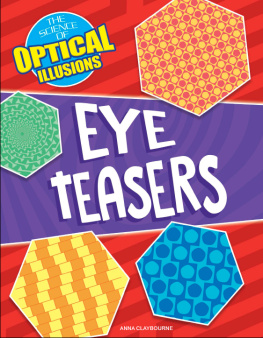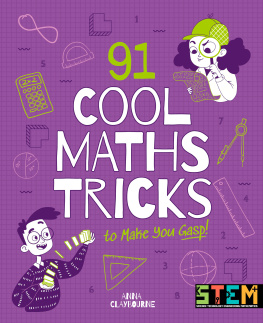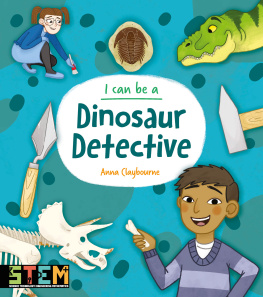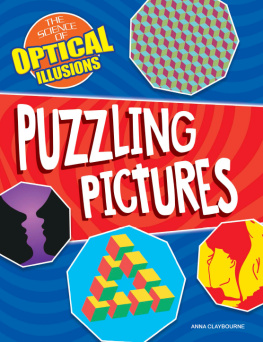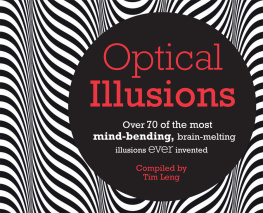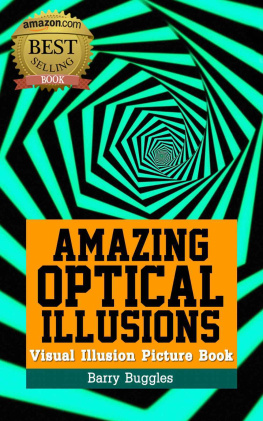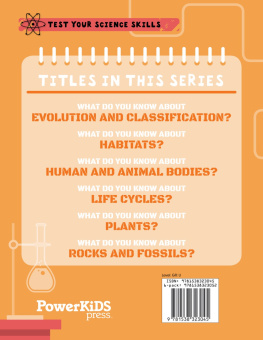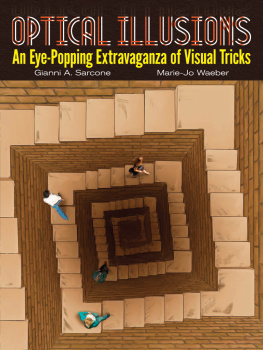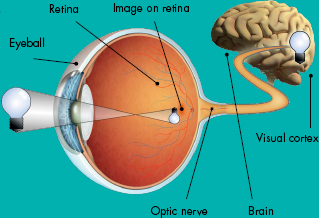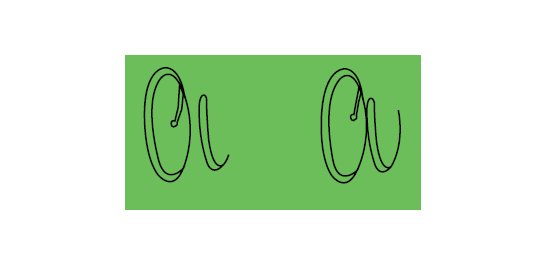Please visit our website, www.garethstevens.com.
For a free color catalog of all our high-quality books, call toll free 1-800-542-2595 or fax 1-877-542-2596.
Cataloging-in-Publication Data
Names: Claybourne, Anna.
Title: Eye teasers / Anna Claybourne.
Description: New York : Gareth Stevens Publishing, 2020. | Series: The science of optical illusions | Includes glossary and index.
Identifiers: ISBN 9781538242414 (pbk.) | ISBN 9781538241851 (library bound) | ISBN 9781538242421 (6 pack)
Subjects: LCSH: Optical illusions--Juvenile literature. | Visual perception--Juvenile literature.
Classification: LCC QP495.C5725 2020 | DDC 152.148--dc23
First Edition
Published in 2020 by
Gareth Stevens Publishing
111 East 14th Street, Suite 349 New York, NY 10003
Copyright Arcturus Holdings Ltd, 2020
Photo credits: p16 r Purves Lab; p17 t Edward H. Adelson; p26 Purves Lab; p27 t Fibonacci; p29 Larry Kagan
All rights reserved. No part of this book may be reproduced in any form without permission from the publisher, except by a reviewer.
Printed in the United States of America
CPSIA compliance information: Batch #CS19GS: For further information contact Gareth Stevens, New York, New York at 1-800-542-2595.
INTRODUCTION
WHAT ARE OPTICAL ILLUSIONS?
The word optical has to do with light and how we see it. An illusion is something that tricks you, so that you dont experience it as it really is.
Magicians and illusionists make impossible things appear to happen. This performer cant really make this die levitatebut he makes it look as if he can.
SEEING IS BELIEVING
When we look around and see things, it feels to us as if were simply seeing the world as it really is. However, thats not quite true. Your eyes and your brain can make mistakes, miss things, or even see things that arent there. An optical illusion is a picture that takes advantage of these mistakes to play a trick on you.
HOW HUMANS SEE
Light rays from objects enter the eye.
Light hits the retina at the back of the eyeball.
Light-sensitive cells in the retina detect patterns of light.
The cells send signals to the brain along the optic nerve.
The brain interprets the signals to figure out what they mean.
TOO MUCH INFORMATION!
All day long, theres a constant flood of images entering your eyes and zooming into your brain. Theres so much information, your brain simply cant process it all carefully.
Instead, it decides what its looking at by matching the light patterns it sees to its memories and previous experiences. It ignores or shuts out things that dont seem important and will quickly jump to conclusions to save time.

Heres an example. What can you see in this picture?

Most people would see two friends riding these.
In other words, bicyclesmachines with two round wheels of equal size. But you only see that because of your brains knowledge and experience. The wheels you actually saw look like this:
ILLUSIONS GALORE
This book is packed with incredible optical illusions to bamboozle your brain from clever shadows to pictures that seem to change color.
Turn the page to get started!
LOOKING CROOKED
Straight or curved? That is the question!
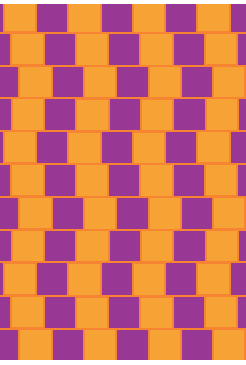
Take a look at this tiled pattern, and answer the simple question: Are the narrow orange lines straight? They cant be! They look like they're all over the place and totally wonky.
Butyou guessed itthey actually are all straight and all perfectly parallel to each other. Dont believe it? Take a pencil, and line it up between them.
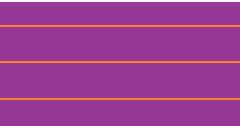
In fact, if you took away the bricks in between, the picture would look like this.
How Does It Work?
Its the positioning of the tiles in a zigzag pattern that confuses the brain. Were more used to seeing simple checkerboard or brickwork patterns, in which darker and lighter areas are evenly balanced. In this pattern, the darker bricks run in zigzags. This makes the orange lines seem unbalanced and appear to lean toward each other.
Thats Weird!
This is called the caf wall illusion, since it was spotted on a real tiled caf wall in Bristol, UK, in 1973. Imagine being the tiler who had to make the pattern youd constantly be thinking youd done it wrong!
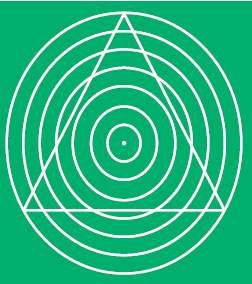
Distorted line illusion
BEND IT LIKE HERING!
This is one of the simplest crookedlooking illusions of them allthe Hering illusion. A spoke-like background makes the red lines look bent, but of course, theyre not! (Test them with a ruler.) Though it seems so simple, scientists havent yet been able to agree on exactly how it works.
To make your own illusion, trace the black lines, then try adding different shapes, such as a square or circle, on top. What happens to them?
THE SQUASHED TRIANGLE
In this illusion, a triangle sits on top of a bull's-eye of concentric circlesbut try as you might, you cant see it as a normal triangle. It looks all squashed and pushed in. The lines around it make the triangles sides seem to curve away from them, so they look bent.
Brain-Boggling!
Its actually really hard for your brain to simply see things on their own. Its always comparing lines and shapes to whats around them. This helps the brain decide what its looking at.

Hering illusion
BIGGER OR SMALLER?
When you look at two objects, its bigger and which easy to tell which is is smallerisnt it?
Well, no! Estimating sizes can be horribly hard for the human brain.
TITCHENER ILLUSION
In this famous, very simple illusion, you see two flower shapes, each with a dot in the middle. Which of these middle dots is bigger?
To your brain, the yellow circle below probably looks bigger. But they are both actually the exact same size.
How Does It Work?
If you want to know exactly how big something is, you can measure it. But our brains dont come with an accurate tape measure installed. Instead, when we look at things, we make an instant guess about their size based on clues from the surroundings. When something is surrounded by smaller objects, it looks biggerand vice versa.

